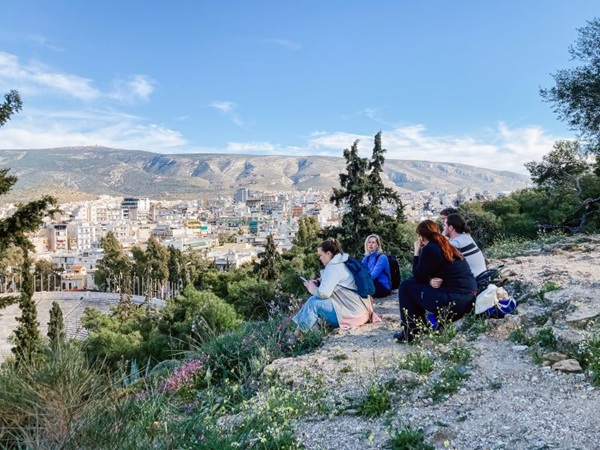Discovery Trail: Learning outdoors with digital technologies

Meet Elina Malleus-Kotšegarov and Jaanus Terasmaa, members of the interdisciplinary research group, SEEMIK, at Tallinn University. With a team of specialists in ecology, education, psychology, digital technologies, and communication they support educators in teaching about complex topics such as climate change and biodiversity. Together with partners in Austria, Finland and Greece they are running the Erasmus+ project, Discovery Trail, combining their respective expertise in non-formal education, technology-based learning, and biodiversity.
Could you explain how the Discovery Trail works?
The Discovery Trail is a digital outdoor learning tool featuring educational journeys on a virtual map. Students navigate outdoor trails in a park, a forest or another natural habitat encountering prompts and questions on complex environmental topics such as biodiversity and climate change at pre-specified locations. Students can see the questions only if they are close enough to the trail points. Students’ responses are collected and provide a comprehensive report on student knowledge both to students and to their teachers. While teachers themselves can create trails and questions for students, together with expert teachers we also created sample pathways that were tested, validated, and translated into the languages of the project partners: English, Estonian, Finnish, German, and Greek. These trails are specifically designed to address complexity and are complemented by a training and detailed manual for educators and non-formal education specialists.
What are some of the challenges of teaching about complex systems and how does your project address those?
With our expertise in educational and developmental psychology, we understand why it is difficult for students to learn about complex concepts (e.g. biodiversity or climate change). So, during our teacher trainings we teach about complex systems, why they are a conceptual challenge for students, and how to best support the learning process. We believe that if teachers have better knowledge about complex systems, then it is easier for them to create trails and questions that support students’ learning. We also tailor our trails to different age groups, ensuring an age-appropriate understanding of complexity.
What are the benefits and challenges of digital tools?
Having the questions on a digital device in one place makes the information more accessible and easier to share with students. At the same time, one of the main difficulties of using a digital device is that students might be more on their phone than in nature. So, you must be very careful with how the tool is used. It is important to create the trails in ways that the students are not always on their phones. We advise having few questions and groups of students who need to work together and discuss the questions. To minimise distractions, we also recommend using school devices, if available.
What is some of the feedback you received from students and teachers?
Teachers told us that the Discovery Trail platform taught them how to better integrate complex topics in their everyday teaching. For example, an English teacher started to realise how she could discuss biodiversity topics in the classroom. Students also enjoy exploring nature by being outdoors and answering the questions. They kept on asking: Can we do it more? So, we created more trails and opened them up to more schools than we had anticipated.
Which challenges did you face along the way? And how did you address them?
Initially, there were some technical problems or country-specific issues when using the platform, but the teachers’ feedback helped us improve the platform quickly. Another challenge was the choice of topics to include in the five days of teacher training. We decided to introduce a pre-training session in each country where teachers could already get to know one another and get familiar with the platform. Overall, we faced few challenges because we were lucky to have great communication and diverse expertise between the different partners.
What do you hope to achieve in the coming years?
We are entering our third year of the project with an upcoming teacher training in Helsinki and multiplier events where teachers join both in person and virtually. We are looking to create a network of teachers who have participated in teacher training to support their peers. In every country, new interested teachers could then reach out to the network and receive information on how to use the platform. Our goal is for teachers in every country to use the Discovery Trail platform. We also wish to continue working with our partners on future projects and develop the Discovery Trail further, for example including new possibilities offered by AI.
What is one thing everyone could learn from your project?
The power of collaboration and diverse expertise enriches projects immeasurably.
Find out more about the Discovery Trail project.
Additional information
-
Education type:School Education
-
Evidence:N/A
-
Funding source:Erasmus+
-
Intervention level:N/A
-
Intervention intensity:N/A
-
Participating countries:AustriaEstoniaFinlandGreece
-
Target audience:TeacherStudent TeacherHead Teacher / PrincipalPedagogical AdviserTeacher Educator
-
Target audience ISCED:Lower secondary education (ISCED 2)Upper secondary education (ISCED 3)
